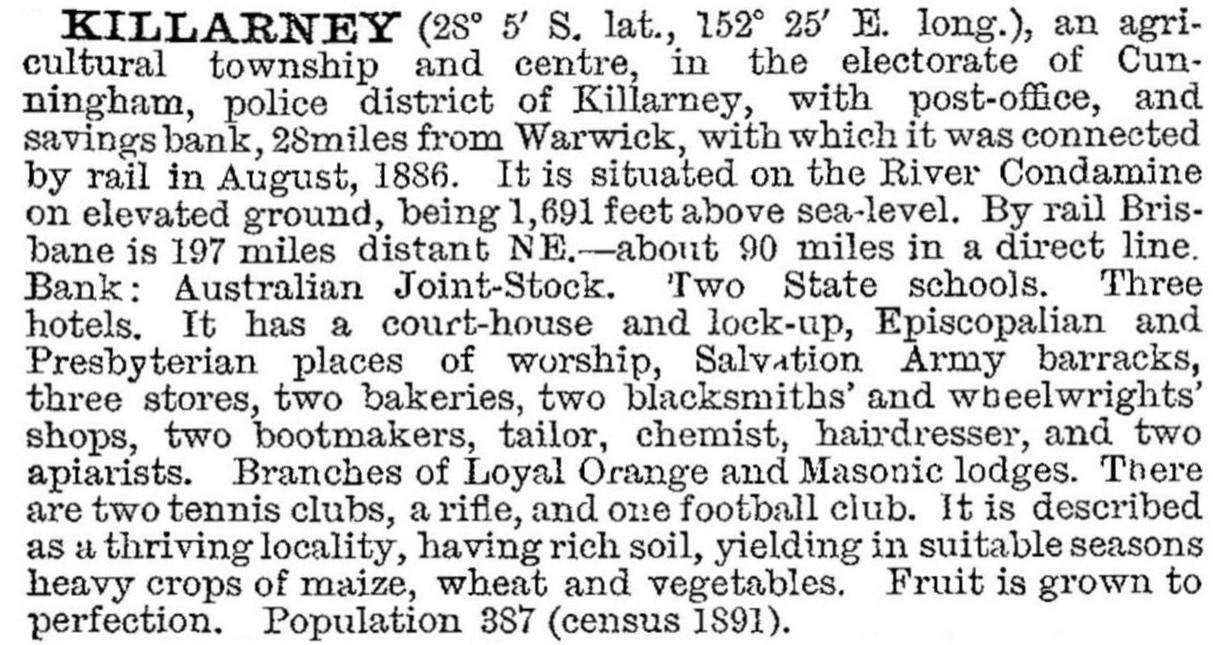Killarney, a rural town a few kilometres from the New South Wales border, is 120 km south-west of central Brisbane. It is in elevated country, on the headwaters of the Condamine River.
The precise origin of the name is uncertain. There was a Killarney Station, an outstation of the famous Canning Downs pastoral run, about eight kilometres down the Condamine from the present town. There were also several picturesque lakes in the valley, fringed by wooded hills, reminiscent of Killarney, Ireland.
Killarney's first important industry was cedar cutting, beginning in the 1850s. In 1867-68 the Killarney Inn was opened. The site for the Killarney township was surveyed about ten years later, by when there were also a general store, a police station, a school (1874) and a blacksmith. It was during the 1880s that Killarney laid down its infant institutions: Presbyterian and Anglican churches, a Queensland National Bank branch, a school of arts and, most significantly, the railway line in 1885 to the north-side of the river. The positioning of the terminus caused businesses to drift from the original south-side township to around the railway station. Killarney was also made the administrative centre of the Glengallan local government division (1879), a district that extended north-west to Warwick.
With a population of over 600 people, Killarney was described in the Australian handbook in 1903:

In addition to crops and fruit, Killarney was suitable for dairying. A cooperative butter factory was opened in 1907, continuing until 1974. There was also the Royal Hall (next to the Royal Hotel), which doubled as a cinema from the 1930s until being burnt down in 1954. Killarney's first agricultural show was held in 1907.
A golf course was laid out in the 1930s and a swimming pool was opened in 1940. After a succession of private medical practices and bush-nursing hospitals, a memorial hospital was opened in 1950. The railway was closed in 1964, but it has been replaced by the Q-Link road freight service. Killarney's role as a municipal centre ended when Glengallan Shire was amalgamated with Warwick.
Killarney's participation in heritage tourism received a blow in 1968 when several important buildings including the old municipal powerhouse, were destroyed by a tornado. Nevertheless, there is a heritage centre at the former First Queensland National Bank building (1913). A national park at the Queen Mary Falls on the Condamine's headwaters is a further attraction.
Killarney has a State p-10 school, a showground and a large retail cooperative. The abattoir closed in February 2010 when the Leitch Pastoral Group ceased operations, with a loss of over 100 jobs. It has an annual rodeo and a country music festival. Killarney's census populations have been:
| Census Date | Population |
|---|---|
| 1891 | 387 |
| 1911 | 1533 |
| 1954 | 1059 |
| 2006 | 831 |
| 2011 | 984 |
Claire Schofield, ed, Memories of Killarney and district, Killarney, Killarney & District Historical Society, 1999
Killarney: the story of its district and school, Warwick, Warwick Newspaper, 1974















